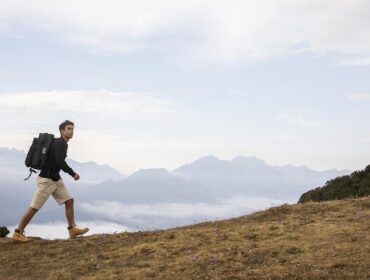When most people hear “island,” they picture palm trees and summer heat. But seasoned hikers know better—hiking destinations don’t need sunburns and sand in your shoes to be spectacular. In fact, the best time to explore America’s island trails might just be when the crowds have gone home.
Off-season hiking brings crisp air, wide-open paths, and a slower rhythm. It’s when nature feels raw and real. You’ll find fewer lines at the ferry dock, better prices at inns, and—best of all—trails that feel like yours alone. Whether you’re searching “hike near me” or planning a quick getaway, island trails offer a unique kind of escape.
This guide rounds up some of the top hiking destinations in the U.S. where you can explore coastal cliffs, forested paths, and oceanfront views—all without the high-season chaos. Grab your boots. The islands are calling, and the best season is just getting started.
1. Mount Desert Island – Acadia National Park, Maine

Acadia isn’t just a fall foliage destination—it’s a year-round hiker’s dream. Located on Mount Desert Island, this park offers some of the most scenic and challenging trails in the Northeast. And once autumn crowds fade, the island transforms into a peaceful, wind-swept wonderland.
The trails here vary from quick overlooks like Ocean Path to adrenaline-pumping climbs like Beehive and Precipice. Cadillac Mountain remains the crown jewel—offering a summit sunrise that, on clear winter mornings, makes you feel like you’re on another planet. Cooler temps mean less sweat, fewer bugs, and more solitude.
Off season also means fewer cars, more open parking, and a better chance to hear your boots crunching on frost-covered granite. Acadia in winter is raw, stunning, and surprisingly accessible—just be prepared with microspikes and layers.
2. Santa Catalina Island – California

Just an hour’s ferry from Los Angeles, Catalina Island feels like it belongs to another world—especially after summer ends. The Trans-Catalina Trail stretches across 38.5 miles of wild, open terrain, making it one of Southern California’s most unique hiking destinations.
In the off season, the island slows down. The air is cooler, the trails less crowded, and the bison more visible. Yes—bison. You might share the trail with them as you hike from Avalon to Two Harbors. If multi-day treks aren’t your thing, shorter loops near Avalon still offer stunning views of cliffs, ocean, and remote coves.
Weather in the off season is mild and dry, ideal for hiking without overheating. Campgrounds stay open, and the sunsets feel a little more magical when you’re one of the only people watching.
3. Cumberland Island – Georgia

Cumberland is wild in the best way. Accessible only by ferry, this barrier island offers over 50 miles of trails through salt marsh, oak forest, and undeveloped shoreline. In the off season, the mosquitos take a break—and so does the crowd.
Start your hike at Sea Camp and head north. Visit the hauntingly beautiful Dungeness Ruins or continue on to wilderness campsites deeper into the island. You’ll pass wild horses, armadillos, and—if you time it right—massive loggerhead sea turtles.
Cumberland is one of the most underappreciated hiking destinations in the South. It’s quiet, remote, and deeply peaceful. There’s no cell service here, which means you’re truly off-grid. Bring food, water, and a love for slow, scenic miles.
4. Whidbey Island – Washington

An easy ferry ride from Seattle, Whidbey Island is all about drama—weather, cliffs, history, and views. It’s green and foggy, with trails that wander through old-growth forest and bluff-top paths that overlook the Puget Sound. It’s ideal for hikers who like a side of mood with their miles.
Start with Ebey’s Landing for a classic coastal route—moderate in effort, high in reward. Watch for bald eagles and storm clouds rolling in over the water. You’ll also find shorter trails in South Whidbey State Park and serene forest walks around Deception Pass.
Winter here means mist and moss, but that’s the charm. Dress warm, expect some puddles, and lean into the atmosphere. If you’re looking for great hiking spots that are close to the city but feel remote, Whidbey delivers.
5. Mackinac Island – Michigan

Mackinac might be known for fudge shops and carriage rides in summer, but off season tells a different story. In winter, this Michigan gem slows to a near standstill. The ferry stops running. Snow falls. And the trails are yours to roam.
The 8.2-mile perimeter trail circles the island, offering frozen lake views, frosted cliffs, and wide-open skies. Inside, wooded trails lead to Arch Rock, Fort Holmes, and other landmarks, now free of summer crowds.
Bring snowshoes if it’s deep, or sturdy boots if it’s just cold and clear. You’ll feel like you’ve stepped into a snow globe version of island hiking. And that silence? It hits different when the only sound is your own breath and boots crunching snow.
Mackinac is one of the most surprising winter hiking destinations in the Midwest. It’s scenic, strange, and somehow soothing.
Final Thoughts: When the Ferry’s Empty, the Trails Are Full of Magic
Hiking doesn’t stop when the temperatures drop. In fact, some of the best moments happen when the beaches are empty, the trees are bare, and the islands finally breathe. These off-season hikes aren’t just quieter—they’re richer. Slower. Deeper.
Each of these island trails gives you something different: solitude, ocean air, wildlife, history, and that unbeatable feeling of finding the trail all to yourself. So whether you’re hunting for great hiking spots or planning your next off-grid reset, remember that the off season isn’t the time to stay home. It’s the time to wander where others won’t.
And if you’re searching for the best hikes in the US, don’t sleep on the islands. They’re waiting—with wind, waves, and miles of trail ready to meet your boots.
FAQ: Your Off-Season Island Hiking Questions, Answered
Are island hiking destinations safe during winter?
Yes, with proper planning. Check ferry schedules, weather alerts, and pack layers. Always bring backup supplies.
What makes island hikes better in the off season?
Less heat, fewer bugs, no crowds. You get solitude, lower prices, and a more personal connection with nature.
Do I need special gear for island trails in colder months?
Waterproof boots, thermal layers, and traction aids like microspikes are smart for trails with snow or ice.
Can I hike these spots without camping overnight?
Absolutely. All featured destinations have day hikes, though some offer excellent overnight or multi-day options.
Can I camp on these islands in the off season?
Some offer limited winter camping (like Cumberland and Catalina). Permits are often easier to get this time of year.





